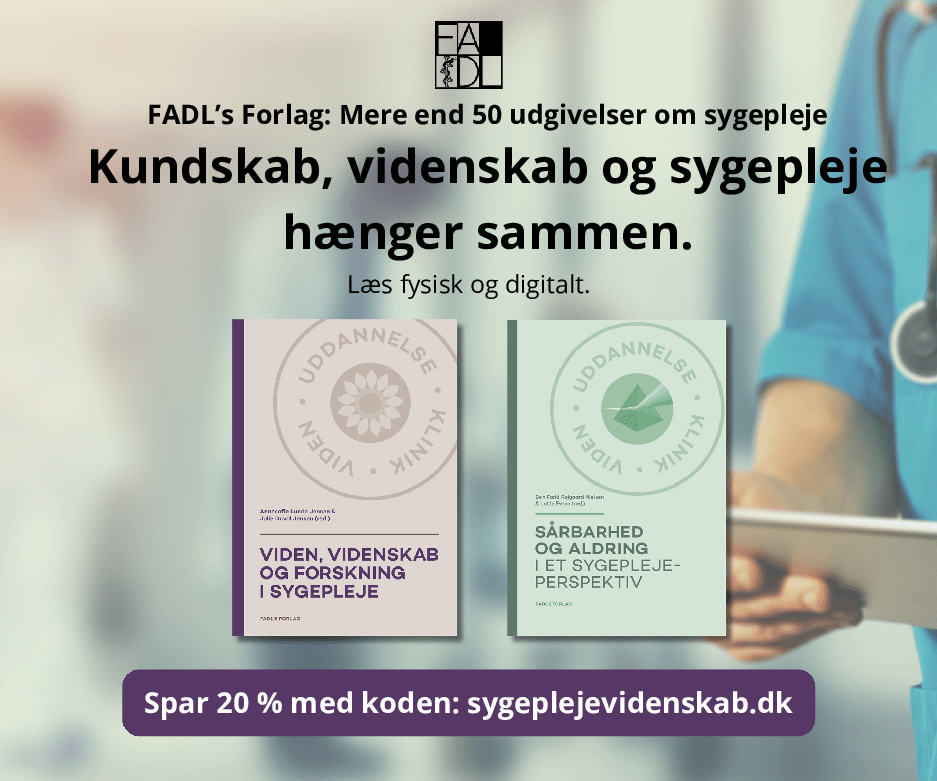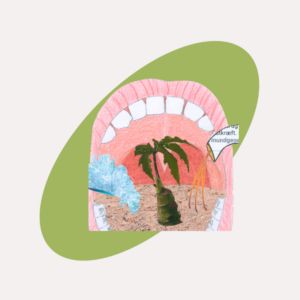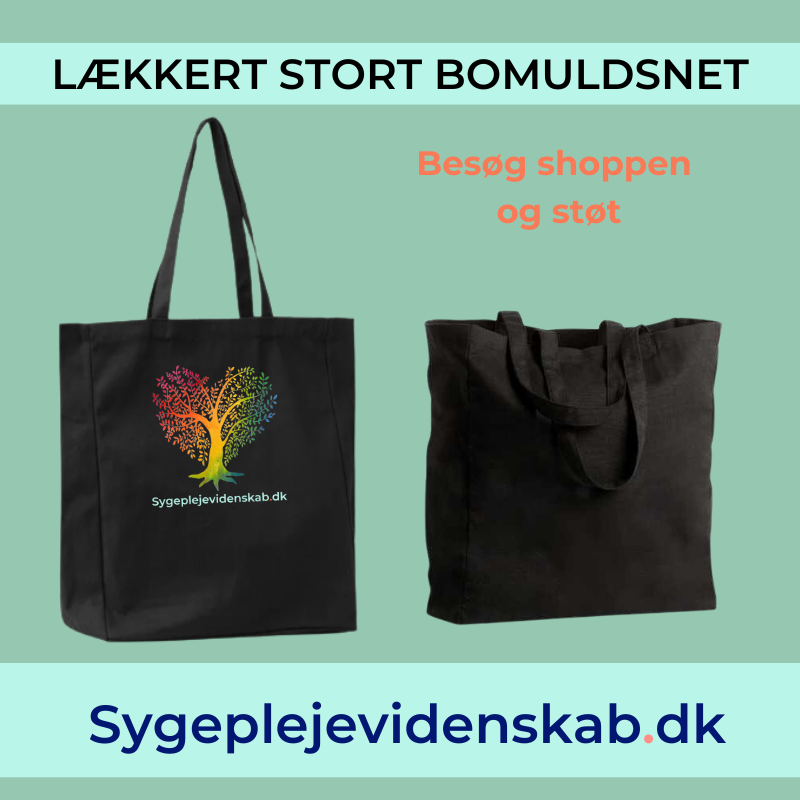
Navigating the real world: The value of supervising Honours student nurses during home-based visits – An ethnographic case study of Honours nursing students’ semantic distributions.
Cecilie Betzer 1,2,3, RN, MHOD, MA in Education, Phd-candidate,
Kristian Larsen 1,3, RN, PhD, Research Director, Professor, UCSF,
Niels Sandholm Larsen 2, RN, PhD, Associate Professor,
Anette Hindhede 1,3, RN, Ph.D., Senior Researcher/Associate Professor
Lee Rusznyak 4, BSc, BPrimEd, BScHons, PhD, Professor
1 UCSF (Center for Health Research)
2 Copenhagen University College
3 University of Copenhagen
4 University of the Witwatersrand, School of Education

[Danish introduction]
Værdien af at vejlede sygeplejerskestuderende i hjemmeplejen – Et etnografisk casestudie af honours sygeplejerskestuderendes læringspotentialer
Introduktion
Sygeplejestuderende skal fremadrettet i deres sidste kliniske undervisning, indgå i normeringen, som en del af den nyligt vedtagne trepartsaftale. Mens der forsikres om at dette ikke vil påvirke de studerendes læring, viser dette studie hvordan in-situ supervision fremmer en dybere forståelse af sygeplejefaget, der understøtter og styrker de studerendes evne til at integrere teori og praksis.
De studerendende der følges med en vejleder, ser 3 gange oftere komplekse sammenhænge og trækker 7 gange så ofte på teoretiske indsigter i deres kliniske beslutningstagen, i forhold til u-superviserede studerende. U-superviseret praksis er derfor ikke alene problematiske både hvad angår læring, men også for sygepleje, fordi nogle studerendes tilgang – i kraft af deres novicestatus – gør plejen fragmenteret, med et større fokus på opgaveløsning frem for omsorg. Med tanke på fremtidens demografiske ændringer er der ikke råd til at læring og forståelse for feltets kompleksitet og muligheder forringes, under de studerendes kliniske undervisning.
Abstract
Introduction
This study explores Honours students’ enactment of home-based nursing during their internships. The emphasis is on examining how the structure of these internships impacts the students’ chances for knowledge building and, consequently, enhances the quality of their learning experience.
Method
The study employs a case-based approach, concentrating on four Honours nursing students who were meticulously observed over a period of two days each, using shadowing ethnography, as they provided home-based care. Furthermore, interviews were conducted with the students, one supervisor, and individuals overseeing the internships. We utilized analytical tools from the Semantics dimension of Legitimation Code Theory (LCT) to analyse the students’ enactment of practice based on their reflections and actions.
Findings
Notable differences were identified between how the students drew on knowledge and principles when they were with a supervisor who were actively mediating the home-based visit versus when home-based visits were completed by themselves, without supervision. This was recognized, in LCT terms, as differences in the codes the students’ enacted and the semantic range of their knowledge-building.
Conclusion
This study emphasizes the importance of the organization of the students’ internships, so that the individual – through supervision – is given the opportunity to deepen the quality of their learning with intentional practice through insights, according to the learning components of the education specifically and the subject field of nursing in general.
Keywords: nursing education, supervision, home-based nursing, semantics, Legitimation Code Theory
Introduction
The work in home-based nursing care differs in many ways from hospital work, primarily because home-based care nurses often provide care alone. Even though home-based nursing has extensive protocols, guidelines, and flowcharts like those found at the hospital wards, the nature of the work calls for a more pragmatic and flexible approach where the nurse needs to consider a whole range of contextual factors when providing care (1,2).
The conditions of the work – within the patients’ own homes – further influence the treatment options available to the nurse, where standardized approaches often need to be adapted to the contextual realities, which requires some sort of experience combined with the ability to draw on knowledge and insights from various fields to make sound and ethical decisions.
According to EU directives (3), it is a requirement in nursing education to have completed clinical internships in seven fields, including home-based care. Given the limited time available for internships and work-based learning, each interaction with a patient offers valuable learning opportunities. This study investigates the differences in how Honours nursing students extract learning in home-based nursing during their regular internship based on their expected increased theoretical knowledge base, both with and without accompanying supervisors. We ask:
How does the organization of home-based nursing in clinical practice influence honours students knowledge-building?
To answer this, we need a set of analytical tools that will enable us to see how nursing students enact their practices when doing home-based visits. Since we are interested in how they integrate different kinds of insights from theory, from the patients and the context and thereby make reasoned judgements about actions – what they choose to do and why – our research questions will be operationalized empirically using the Semantics dimension of Legitimation Code Theory (4–6).
Empirical data is generated from ethnographic shadowing of nursing students doing their internships in home-based care combined with interviews with key personnel regarding the organization of student internships.
Knowledge in nursing
The competency goals for the Danish nursing education are divided into ‘knowledge’, ‘skills’, and ‘competencies’. ‘Knowledge’ pertains to theoretical understanding and recognition of a specific professional area or subject. ‘Skills’ refer to the ability to apply this knowledge in practice, including practical, technical, and cognitive skills such as analysis and problem-solving. ‘Competencies’ encompass the ability to integrate knowledge and skills in complex situations, demonstrate independence, take responsibility, and effectively and professionally handle tasks. (7).
This requires three forms of knowledge, as prerequisites for action (8) :
‘knowing what’,
‘knowing how’
‘knowing why’
However, a challenge is that nursing encompasses a diverse knowledge domain, which can make it difficult to ‘translate’ and integrate the often context-dependent insights that students acquire through education at the University College into clinical practice. This might limit the ability to connect and apply real competencies in new situations (9).
In preparation programmes like nursing, which include both university college coursework and internships, it is essential to prioritize cumulative knowledge-building to ensure that students develop a robust foundation of knowledge and skills that can be applied effectively in real-world settings. This involves connecting and expanding existing knowledge by integrating insights from diverse situations and areas over time, as mentioned by Maton (4).
One way cumulative knowledge-building can occur is when experiential knowledge creates opportunities to extract general ideas from specific contexts, enabling the conceptualization of knowledge that is applicable beyond its original situation and providing valuable insights into future or changed contexts (4,9). Thus, this knowledge construction occurs using theories to guide practical actions, subject to scrutiny and adaptation to the specific context.
This dynamic interaction involves both personal experience, intricate, abstract, and transferable knowledge and should not be left to chance or to the students themselves, as learning objectives may not always capture the differences between the ‘logic of school’ and the ‘logic of (many different) practice(s)’ (4). This challenge is not only experienced in nursing but tends to be encountered in other fields as well, such as in teacher education (10,11), engineering (12), and others.
Context
The decision to focus on home-based nursing as the subject and context of research stems from a report by Copenhagen University College. This report revealed that internships in primary care received satisfaction-scores 20% lower than those in hospitals. Additionally, 53% of students expressed feeling insufficiently challenged, and 43% reported completing their internship without supervision during home-based visits (13).
In the light of changing demographics, where more elderly individuals will receive care at home in the future (14–16), and considering that primary care traditionally is viewed as a low-status area in nursing (17–20), these statistics are cause for concern. Student nurses must be prepared not only to handle common conditions but also to care for patients in diverse environments that differ from hospital settings, where the implementation of clinical procedures and protocols occurs in highly specialized and controlled environments.
Elderly patients typically do not just have a single illness but often present with multiple concurrent and competing diagnoses and comorbidities (21). This requires specialized competencies among nurses – competencies that Jarrin (22) claims are lacking in a hospital-centred nursing curriculum leading to students’ lack of gerontology-related skills (23).
If this is compounded by instructors lacking experience in the unique aspects of primary care, who could otherwise serve as strong role models from the field for the students, it can result in the students often disregarding the principles guiding nursing practice in home-based care, along with the associated responsibilities (24).
Since elderly care in the primary sector is unpredictable, a highly skilled and knowledgeable nursing force is required (1,2,15). There is an urgent need for nursing preparation programmes to foster the ability to apply their knowledge of treatment within a large range of home-based contexts.
Facing challenges in recruiting and retaining nursing students, particularly amidst the growing complexities in the primary sector, Copenhagen University College took action in 2021. They established an Honours programme, Copenhagen Honours College (CHC), with a targeted focus on preparing student nurses to provide home-based care to elderly medical patients, aiming to elevate primary care nursing as a prestigious career path and tackle retention issues head-on.
This programme seeks to engage and retain motivated nursing students by introducing heightened academic and practical challenges, equivalent to half a year of full-time studies, during the final two years of their education. While students continue their ordinary coursework in theory and practice, the Honours programme supplements their learning with specialized theoretical instruction and individual clinical experiences.
Ultimately, the goal is to ensure that graduating students possess both the necessary competencies and the desire to pursue employment opportunities, particularly within the primary sector.
The extended competency profile for Honours students emphasizes a synergistic blend that demands a strong connection to the context combined with substantial theoretical insight, exemplified by e.g. “[…] providing specialized nursing care to elderly medical patients with an evidence-based approach” (Programme regulation, CHC).
This approach underscores the acquisition of knowledge through theory rather than solely through practical experience and a particular ‘gaze’ akin to the pedagogical strategies employed in the setting of ordinary nursing education. The programme’s success hinges on effectively bridging theoretical insights with the application of home-based treatments in real-life contexts.
We will start out by describing the conceptual tools offered by the Semantics dimension of LCT and, thereafter, the method. Afterwards, the students and their internship will be analysed using the tools.
Legitimation Code Theory: Introducing the Semantics dimension
Legitimation Code Theory (henceforth LCT) is a sociological approach developed by Karl Maton (4) that is widely used to study how people learn and enact knowledge practices. It extends and integrates the ideas of Basil Bernstein, Pierre Bourdieu and a range of other theoretical insights. The theory posits that social actors in fields of practice exemplify what they perceive as legitimate ways of behaving, acting, and thinking within those settings. The diverse dimensions of LCT provide sets of concepts and analytical tools necessary for investigating how participation and success in knowledge practices are understood and achieved (4). Semantics generates how meaning in practice is legitimated.
The basis of legitimation is generated by two organizing principles, namely semantic gravity, which considers context-dependence of how practices are enacted, and semantic density, which considers their complexity.
In this study, we regard home-based care as a knowledge-driven practice. Semantics provides the tools to analyse how home-based care can be enacted in varying levels of context-dependency, with differing levels of complexity.
Through the application of Semantics, we can examine how students explain their actions during home-based nursing visits, with varying degrees of supervisor support. This analysis will uncover the degree to which they integrate their decision-making during practical field experiences with the insights gained from their university college coursework.
It is important to note that both semantic density and semantic gravity are consistently present and are defined in varying strengths along a continuum.
(I) Semantic gravity (SG)
Semantic gravity refers to how strongly meanings are bound to context (5). The stronger semantic gravity (SG+), the more difficult it is to extract meaning out of context. In the case of home-based nursing, stronger semantic gravity could refer to specific actions/interactions between the nursing student and the patient. One example of SG+ could be when – for example, in the context of administering medication – the student draws on previous knowledge about the patient and inquiries about the patient’s lived experiences in the period between the current visit and the previous one, such as asking, “Have you lost weight?”. This inquiry does not have a direct relation to the assigned task and is tied to the specific context (SG+). In contrast, the broader guideline of weighing all patients at risk of malnutrition once a month for ‘early detection’ should be viewed as SG-, illustrating how the semantic gravity weakens as it is generalized and applied across various contexts.
Practice with relatively weaker semantic gravity (SG-) signifies knowledge of a more general nature. Given that semantic gravity is consistently present, its relative strength will often fluctuate throughout a series of actions, as exemplified in the following.
The supervisor asks the student why she thinks Aquasel should be applied here (SG+). The student describes how she assesses the wound to be in the healing phase (SG+) and Aquasel helps to release ions that ensure better wound healing in general (SG-)(field notes).
The supervisor begins by focusing on a bandage with a specific function, which the student is assessed to understand the theory behind (SG-) and asks the student to connect this knowledge with what the student observes; the student assesses the specific wound (SG+) and returns to theoretical principles of wound care combined with knowledge of the functions of the specific dressing (SG-).
In order to ensure rigour and transparency between empirical data and analysis, it is necessary to use a translation device (Table 1 ), that can articulate the coding of what is observed as respectively SG+ and SG- (25).
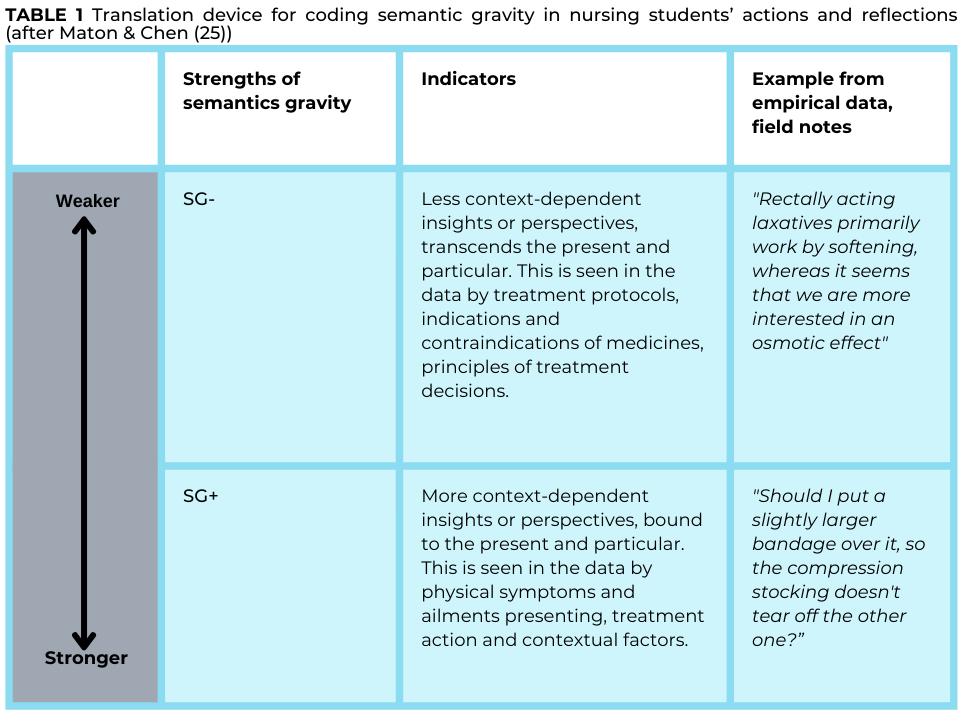
(II) Semantic density (SD)
The second organizing principle, semantic density, refers to the degree of condensation of meaning and degree of complexity in the enactment of a practice (5). The stronger semantic density (SD+), the more meaning is infused into the actual practice in which students engage, or the more intertwined it is with other bodies of knowledge or practices, manifesting internally as condensation or externally as a network of meanings.
The weaker the semantic density (SD-), the less intricate the student’s reflections on the given event or the less comprehensive the array of meanings involved. A task performed in isolation, such as recording a temperature, embodies a weaker semantic density (SD-), (Table 2).
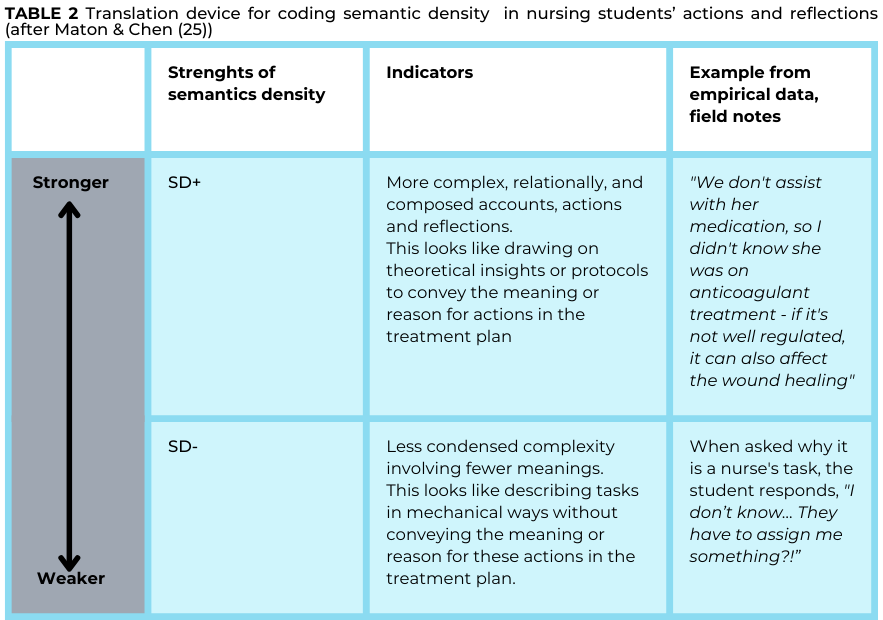
On the other hand, interpretation, which involves sensitivity to and understanding of a given problem, enhances semantic density (SD+). In the context of the aforementioned temperature measurement, this interpretation might entail reflecting on the reasons behind the temperature increase. Subsequently, it could involve considering potential treatment options for the patient, both pharmacological and non-pharmacological, taking into account factors such as the patient’s current medications and underlying conditions.
Furthermore, the decision of whether to contact a doctor could also be part of this interpretation process. Strengthening the semantic density involves referencing theoretical insights from various scientific areas and drawing connections based on past experiences.
When the semantic density strengthens, the students reflect on current events, e.g. based on a wider amount of theoretical knowledge, which makes their reflections more complex (SD+):
“But things are interconnected, right?
So, her constipation is perhaps a kind of side effect of her inactivity, which is part of her depression, isn’t it?”(field note).
Or the semantic density could strengthen due to vast amounts of practical experience:
“My experience tells me that if you supplement the pharmacological treatment with, for example, exercise and a fibre-rich diet, patients experience fewer side effects, which in itself makes them more compliant”(field note, supervisor).
Complex reflections incorporating knowledge from multiple areas are the cornerstone of clinical decision-making, which is a fundamental goal of nursing (26,27).
(III) Codes on the semantic plane
The legitimacy of knowledge construction in practice, such as home-based nursing, relies on the considering of both semantic gravity and semantic density. These two organizing principles can be depicted relationally on the semantic plane. Students’ interpretations of their practice can be positioned on this plane, delineated into four distinct areas, each governed by varying strengths of semantic gravity but not necessarily correlated with semantic density. Maton (4) delineates four semantic codes that can legitimate how meaning is ascribed to practice. To demonstrate how nursing students navigate between context-specific considerations and broader principles, as well as between different levels of complexity, we can visualize the observations from clinical practice – the distribution of semantic gravity and semantic density – on a Cartesian plane. The Plane is shown in Figure 1.
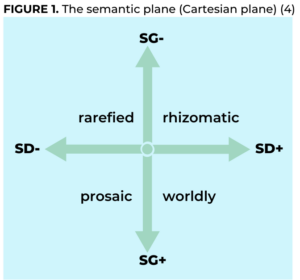
Maton (4,5) argues that the combined strengths of semantic gravity and semantic density generates four analytically distinct codes that legitimate how practices are enacted:
- Rhizomatic codes (SG-, SD+): The reflections and/or actions of the students are less context-dependent and at the same time more complex in the interpretation and stances
- Worldly codes (SG+, SD+): The reflections and/or actions of the students are more context-dependent and complex in the conceptual interpretations and stances and have manifold meanings
- Prosaic codes (SG+, SD-): The reflections and/or actions of the students are more context-dependent and at the same time less complex in the interpretations and stance with fewer meanings
- Rarefied codes (SG-, SD-): The reflections and/or actions of the students are less context-dependent and condense fewer or simpler meanings. (6). (4)
To meet the extended learning objectives set by the ordinary programme as well as the Honours programme, it requires nursing students’ to consciously analyse the patient and the context, recruit insights from theory, and then decide and understand what constitutes an appropriate course of action. Nursing students must not only possess the ability to think like a nurse but also the ability to translate their knowledge into action. By plotting the students’ actions and reflections onto the semantic plane, a distribution pattern is achieved, providing an overview of the organizing principles that guide their practice (9).
Method
In this study, we employed ethnographic shadowing (28,29) to observe students during their internship in home-based care. Ethnographic shadowing involves closely following a single student throughout their daily activities and documenting all interactions and actions, both task-related and incidental.
We invited all Honours students (from two cohorts) who were scheduled for internships in home-based nursing in their 6th semester in both spring 2023 and fall 2023 (n=12) to participate, of whom 7 agreed to participate. Of those who agreed, 4 students were randomly selected. Each student was shadowed for two full working days. Three out of the four included students conducted their home-based nursing visits alone without supervision (this was not an isolated case on the days the observer was present, but standard practice – for one reason or another, according to the students).
Prior to participation, students received oral and written information about the project and provided written consent, with the option to withdraw at any time without explanation. Supervisors received verbal information through their superiors, who had approved our observation of the students.
Additionally, on the day of observation, supervisors received both verbal and written information. The observer only attended visits where patients, after being informed about the project, consented to the observer’s presence. All participants, including supervisors and patients, were de-identified. The observational data from the shadowing were coded and analysed in terms of context-dependence and complexity using the aforementioned translation devices (Table 1 & Table 2). The codes were afterwards plotted onto semantic distribution patterns.
In the upcoming section, using semantic distribution patterns, we will illustrate how the structure of students’ home-based internships, particularly in terms of prioritised supervision, impacts their potential for knowledge-building. We chose to differentiate between students doing home-based nursing without supervision and students doing home-based nursing with supervision, hence we found that the differences had significant influence on the students’ opportunities for knowledge acquisition. Since the three students who conducted home-based nursing without supervision had almost identical distribution patterns, we chose to combine these into one overview.
As the students were observed throughout a full working day, it also means that there are many records for each student since every action – e.g. dressing a wound – consists of a series of actions. For the sake of clarity, we have chosen not to present the students’ actions and reflections in the form of shifts (visualized, e.g. by arrows) between the codes. Instead, the translation devices were used to assign strengths of semantic gravity (SG) and semantic density (SD) to our data.
These distributions can then be interpreted in relation to how nursing students’ practices extend beyond the context’s specifics and become more complex when (and if) supported by interactions with a supervisor during the home-based visit. Further, this approach allows us to tally how many times the students position themselves within each quadrant of the distribution pattern in relation to the total number of entries, thereby making it possible to calculate a percentage share for each position.
Prior to the observations, interviews were conducted with key persons responsible for or involved in the students’ internships in the primary sector – those were subsequently transcribed, guiding the construction of the translation device and analysed using the same translation device as used for the ethnographic data.
First, we will display the distribution pattern for students conducting home-based nursing without supervision. Following this, in the subsequent examples, we will illustrate the impact of the supervisor through, at first, a distribution pattern showing what the students account for alone, followed by what the supervisor accounts for, and lastly, how actions, reflections, and guidance of the supervisor helps the student expand their semantic range. The percentage markings depict the different positions of the students (and supervisor) throughout a working day.
Findings
Home-based nursing without a supervisor
Three out of the four students observed completed their home-based visits alone without supervision. After the educational institution has approved the workplace as a practicum site, the organization of the students’ internships is left to the discretion of each specific location, which can result in significant variations:
“[…] maybe it is because they (the programme management at CHC) do not understand how we are organized in a municipality… it’s very different from a hospital… all our units are like small hospitals with their own management and their own principals, and I can neither determine nor decide, I can only go out there and suggest and guide…”(interview).
To be approved as a clinical teaching site, it requires that the workplace has trained clinical supervisors (1/6 diploma degree) and is believed to have tasks that can support the student’s learning according to the semester’s learning objectives. It is not a requirement for students to follow a supervisor on a daily basis.
The number of students a supervisor is responsible for is influenced by considerations related to budget, daily operations, staff rostering, and other factors. In most cases, clinical supervisors must combine their supervisory duties with daily operational responsibilities, and it is, therefore, up to each educational institution (and individual supervisor) to assess how the learning objectives for the placement can be achieved in clinical practice*(30)
*In Denmark, a distinction is made between ‘clinical supervisors’ (referred to as supervisors in this article) and daily mentors. The clinical supervisor, who holds pedagogical competencies equivalent to 1/6 of a diploma degree, is responsible for planning, implementing, evaluating, and developing internship programmes for the students. Conversely, the ‘daily mentor’, for instance, may be appointed by the clinical supervisor to provide guidance to a limited extent.
However, due to Denmark’s publicly funded education system, all nurses are expected to – and have a responsibility for – provide professional and social support to the students during their internships.
When students are assigned to work independently without a supervisor, it often implies that the tasks assigned to the students are not simultaneously performed by others, and thereby, the students often experience that they are a part of the staffing ratio, which they should not formally be, e.g. expressed through this (far from unique) statement that a student made in an attempt to reflect on the tasks she had been assigned:
“Someone has to do it, and I am cheap labour?!” (field note).
Therefore, students in our study are not only alone during the actual visit but also in their preparations, planning of care, and the daily routines associated with the practice. Based on the preceding discussion, it becomes evident that students experience a significant degree of autonomy and independence throughout their internships, extending beyond the actual patient visits to encompass various aspects of preparation, care planning, and daily routines. This is further exemplified by the student’s account:
The student tells me that we must attend a ‘morning meeting’ before we head out. When I inquire about what the morning meeting entails, she mentions that there is an allocated time of 8 minutes for it but confesses that she still struggles to decipher its purpose, saying”, ”Maybe I’ll figure it out one day” (field note).
As captured in the field notes, the student’s uncertainty reflects the ongoing challenges and learning experiences encountered in navigating the practical aspects of their training.
Despite being reliant on permanent staff in their practice, for instance, when needing to borrow keys to retrieve items (e.g. bandages) for patients or when needing approval for medication orders, the students found themselves mostly left to their own throughout the day, both professionally and socially.
Simultaneously, they lacked the same tools (work phone, keys, etc.) as the permanent staff, placing them in a precarious situation when they actually needed assistance. This places the students in what they perceive as a double negative position: they feel like cheap labour without real learning opportunities, with a singular focus on the task at hand, and at the same time, they are not part of the workplace community.
I asked about how learning takes place doing visits by herself. The student laughs and says, ”I’m glad you’re asking about that” explaining how the first three weeks were spent with a trained nurse, where there was some supervision and reflection, but it was more about learning the routines. She further describes how they occasionally have reflections but not with someone actively involved in caregiving, -”so it becomes a bit superficial” (field note).
When students are scheduled to do visit alone, it often means that their visits become repetitive within the scope of what they already know and can do, as there may be operational advantages to this approach. The visits they are assigned, therefore, fall within what they, as learners, can handle unaided, impacting their opportunities for knowledge-building (31).
Initially, there is nothing inherently flawed with this approach, as repetition, among other things, can instill task confidence. However, within an interactionist learning perspective, there may be doubts about the extent to which students can be expected to learn independently if practical synthesis is not solely attainable through training and experience but also necessitates being enriched by theoretical insights. A student described it very aptly with the words:
“So, one must believe that what one is doing is right” (field note).
As demonstrated in Figure 2 , the analysis reveals notable trends in the distribution of students’ actions and reflections.
It is observed that more than half (52%) of the data falls within the prosaic code (SG+, SD-), indicating a reliance on contextual cues without articulated reasoning, even when prompted. Conversely, only 11% of the data exhibit greater complexity, with a mere 7% (SG+, SD+) demonstrating the synthesis of complex insights.
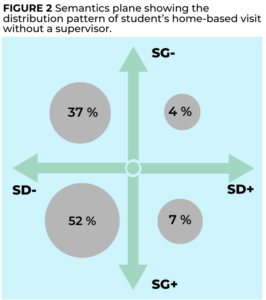
In the subsequent sections, we will substantiate these findings by presenting excerpts from our field observations. These excerpts will be accompanied by reflections aimed at elucidating the underlying reasons for the observed distribution pattern.
As seen in the distribution pattern, students’ enactment demonstrates alternating stronger and weaker semantic gravity. Since nursing itself is deeply rooted in practice, with patients regarded as the primary object for action, students often begin with a strong semantic gravity (SG+) when encountering the patient. However, as they proceed to solve the assigned task, they transition to a weakening of the semantic gravity (SG-), shifting their focus from the patient to the task, treating them as more or less fragmented entities.
After completing the (isolated) task, semantic gravity strengthens again, and the patient once again becomes the primary focus.
After chatting briefly with the patient about how she is doing and what has happened since last time, the student sits down at the table and prepares to administer the medication. The student realizes that the medication she was supposed to administer has already been dispensed and asks the patient who did it and when (SG+, SD-).
The patient gets a bit confused and cannot provide a clear explanation (she suffers from dementia), and the student reassures her that she should not worry about it (SG+, SD-).
In silence the student systematically checks the medication packs against the prescription to ensure they have been dosed correctly and that there is enough medication for the next dose (SG-, SD-).
Since all packages match, we leave the apartment again, assuring the patient that everything is fine (SG+, SD-). After the visit, I ask the student what to do about it and why it happens. The student replies, “I don’t know, maybe someone messed up? I could call the coordinator, but I don’t see how it would help, everything seems fine now”(SG+, SD-) (field note).
A notable observation in Figure 2 pertains to the predominantly leftward movements on the Cartesian plane, indicative of simpler accounts of practice (a weaker semantic density, SD-).
This pattern suggests that students enact tasks as a series of isolated actions, wherein knowledge is selectively drawn from specific domains without establishing connections to more comprehensive, practice-based implications. In this scenario, the student encountered a medication discrepancy during a patient visit. Instead of investigating the root cause or considering broader implications, the student’s response was limited to reassurance and routine checks.
To enhance knowledge-building, the student could have applied principles of clinical leadership to address the error’s origin and implemented corrective measures. Additionally, knowledge of patient-centred care and dementia management could have informed a more empathetic response to the patient’s confusion. Integrating insights from these domains could have enriched the student’s understanding of practice-based implications. This tendency, however, is not so surprising if we understand learning from an interactionist perspective, as one student expressed:
“You only learn what you already know” (field note).
The content deepening and strengthening of semantic density was rarely expressed among the students who did their home-based nursing visits without supervision. This also meant that the students experienced a lack of meaning during internship because the task was mostly viewed in isolation without recognizing its potential complexity in strengthening of semantic density.
Consequently, students often fail to seize opportunities during home-based visits to broaden their semantic range from prosaic (SG+, SD-) and rarified (SG-, SD-) codes to worldly (SG+, SD+) and rhizomatic (SG-, SD+) ones), leading to doubts about whether they truly achieve their learning objectives from a nursing perspective.
For example, this is evident in their ability to engage in clinical decision-making, where students must incorporate and justify their actions using various forms of knowledge as a prerequisite for the ideal of ‘holistic care,’ even though the task is performed in isolation and from a goal-oriented perspective. The theoretical ideas from university college courses and the students’ experiential encounters during home-based nursing visits remain isolated from each other due to the fragmented way they enact practices as novices (26).
When queried about why a particular task constituted a nursing task, students frequently encountered difficulty articulating a response:
At one point, we agree that I should not accompany a particular patient visit, as it involves a man who already does not wish to receive home visits (SG+, SD-) and where the student says she “just needs to check if he has taken his insulin as prescribed”(SG-, SD-). She mentions that the man is of a different ethnic background than Danish and lives with his children and in-laws, but that they always withdraw when home-based staffing comes to visit, so the student plans to make the visit brief (SG+, SD-). When the student returns, I ask why a nurse should conduct such visits, to which the student responds:”
They have to make me do something?”
(SG-, SD-) (field note).
The field note illustrates how the patient’s condition (diabetes) is isolated as a task separate from the person (the man who does not want visits and the relatives who withdraw), without any relation or foundation in other theoretical insights beyond the immediate (physiology/pharmacology).
Home-based nursing with a supervisor
From observation of the one student undertaking home-based visits together with a supervisor (an educated nurse), we have chosen to divide the plane to visualize the three different settings occurring simultaneously:
- the student’s unprompted actions and reflection,
- the supervisor’s actions (and reflections or prompts) going on at the same time as the student’s task-solving, functioning as a role model for the student,
- the shifts that the students do, facilitated by the supervisor.
Thus, the following three figures represent the same setting where actions occur interwoven and simultaneously, as both the student and the supervisor are present at the same time.
All three Cartesian planes thus display the same context and are based on the same empirical data but viewed from different isolated perspectives.
The initial distribution pattern (Figure 3) depicts students’ task-solving and reflections in the absence of supervisor interactions, quite comparable to what was seen in Figure 2.
The observation reveals that students predominantly navigate the left side of the plane, seldom attaining strengthened semantic density. In instances where students undertake another position, these primarily occur between stronger and weaker semantic gravity. Notably, there is an equal frequency of cases where students’ actions and reflections persist within the same quadrant.
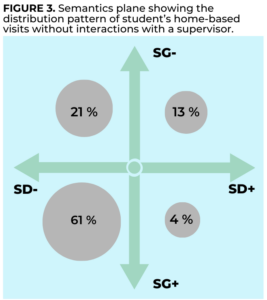
Looking at the supervisors’ distribution patterns (Figure 4) – who are physically present with the student in a more or less withdrawn position – it is possible to see how the positions are distributed with a larger semantic range, spanning all four quadrants in the plane.
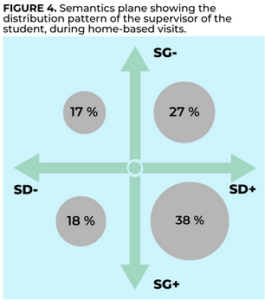
The visits often start out with simpler interactions that focus on the particulars of the context (SG+, SD-), such as greeting the patient and combining the task from the timetable with the situation-in situ:
“I saw that your husband has been admitted – what a mess (SG+, SD-). How are you coping with that?” (SG+, SD+)(field note, supervisor).
This explorative conversation with the patient shows a combination of expected and planned vs. necessary and required, which moves the supervisor from weaker semantic density to stronger semantic density, drawing on the knowledge base. When the supervisor starts solving the tasks, the movement goes from stronger semantic gravity (depending on the inclusion of the patient, based on the patients’ resources, etc.) to weaker semantic gravity, and mostly from weaker semantic density to stronger semantic density and back. Overall, interactions with the patient move in the lower quadrants of the plane, and the task-solving on its own moves between the two upper quadrants of the plane.
The movements made by the supervisor highlight the importance of distinguishing between rhizomatic codes (SG-, SD+) and rarefied codes (SG-, SD-) because there is a difference in what Maton (32) refers to as ‘meaningful ideas (SD+)’ and ‘jargon (SD-)’.
In the same way that there is a difference between ‘insights (SD+)’ and ‘bullshit (SD-),’ as he writes and continues: Similarly, if prosaic codes (SG+, SD-) are the only form of context-dependent ideas, and worldly codes (SG+, SD+) are obscured, the possibility is denied of context-dependent practices being complex (Martin & Maton, 2020 p 66) (32).
Thus, the supervisor demonstrates a sensitivity to reading the context as guiding for their choice of actions, based on theoretical insights. , the supervisor recognizes the potentially immediate yet complex and intertwined nature of the situation, thereby unfolding practice to become precisely the ‘holistic care’ that is aimed for rather than mere task completion.
In their actions, the educated nurse becomes a role model for the student, effectively performing nursing based on knowledge and within the contextual challenges and opportunities that are present:
”Medication dispensing is also a fantastic opportunity for us as nurses to keep a bit of an eye on what’s happening – even though the patient seems cognitively sharp, she is fragile, and just the fact that her husband has been admitted can make everything fall apart very quickly”(SG+,SD+) (field note, supervisor).
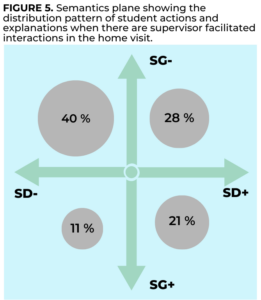
Figure 5 represents an amalgamation of Figure 3 and 4, showing the crucial role of the supervisor being present regarding students’ learning since students’ actions and reflections of strengthening semantic density do not always naturally manifest on their own (as shown in Figure 3). Students seldom reach independent interpretations or assessments of the visits but instead rely solely on general fragmented principles of practice. When the supervisor assists the student through guidance, a more intricate semantic structure with repeated shifts in positions becomes evident. Often, these shifts involve collaboration between the supervisor and the student, where the supervisor’s questions prompt the student to move to another position.
Though, the educated nurse is not just a role model but also assists the student in making shifts during the care process by asking questions like “so what are you thinking? – why is that? What else could it be? and –If not that, then what?” etc. The shifts occur when the educated nurse facilitates the ‘unpacking’ of knowledge (transitioning from SG-, SD+ to SG+, SD-), starting with a theoretical procedure that is weakened through connection to real-life experience and expounded in everyday terminology.
The student has finished dispensing the medication and is placing the pill organizers back into the medicine bag, following the guidelines (SG-, SD-). The supervisor questions why she does not ask the patient where she prefers to have the medication, elaborating that including the patient in the decision might help her remember to take it (SG+, SD-), increasing the overall compliance (SG-, SD+)(field note).
Another shift happens when the educated nurse ‘re-pack’ (going from SG+, SD- to SG-, SD+) knowledge by starting out in the experienced (SG+, SD-) and thereby lifted out of its context explained by specialized knowledge:
After rinsing the first wound, the student asks whether she should discard the catheter or if she can reuse it for the next wound (SG+,SD-).
The supervisor explains that it is always used only once when there is a risk of infection, as the catheter would otherwise be contaminated and could transfer infection from one wound to another (SG-,SD+) (field note).
The educated nurse thereby compels the student to recognize the importance of having nursing-relevant theoretical knowledge from multiple fields (in this context, knowledge on wounds, hygiene, infection, etc.), which is both conceptually complex and contextually relevant.
If the student is unable to progress independently or with minimal assistance, the supervisor makes the next shift to bolster the overall understanding, using sentences like “Yes, exactly… and that is why we […]”.
Therefore, the supervisor contributes to a significantly broader semantic scope that incorporates various semantic codes compared to the students who conduct home-based nursing visits without supervision. The supervisor operates through reflection with the student, reinforcing and affirming the actions and conditions for possibilities while simultaneously helps alleviate some of the organizational complexities inherent in the field.
The supervisor assists by making the known, ‘un-known’ through theorizing, supervision, and reflection on action to create distance and support learning (33). At the same time, the importance of going the other way, where the unfamiliar becomes familiar, is also recognized. The supervisor thereby becomes ‘midwives’ in the student’s ability to transfer knowledge from the left side of the quadrant (SG+, SD- and SG-, SD-) to the right side (SG+, SD+ and SG-, SD+), meaning that the students elaborate from stronger semantic gravity to weaker semantic gravity and from weaker semantic density to stronger semantic density – A step the students cannot take independently, as echoed by a response to inquiries about achieving competence goals during solo visits:
“You only learn what you already know” (field note).
The supervisor creates a cumulative integration of knowledge – a projection (in opposite to the students own sometimes disintegration/introjection). This integration of knowledge is essential as one of the supervisors told:
“[…] some students excel in theoretical knowledge, being able to articulate every aspect, but struggle when working with patients. It is emphasized that possessing the ability to articulate concepts like ‘the motivational interview’ is not very helpful if one cannot effectively apply the theory in practical (SG-, SD-)” (field note, supervisor).
By using semantic distribution patterns, it becomes obvious that supervision plays an essential role in the students’ opportunities for cumulative knowledge-building because the competency profile specifically aims for both strong semantic gravity and strong semantic density, which can hardly be reached by the students by themselves.
Discussion
As indicated by the findings section, the arrangement of the students’ internships in home-based nursing, particularly through supervision, plays a crucial role in broadening students’ semantic range, which is essential for their knowledge-building, as it impacts how they enact practice. With a supervisor present alongside the student, there were three times as many instances of utilizing complex insights to account for the treatment of patients in the context of home-based visits, seven times more incorporation of theoretical insights from rhizomatic codes, and in general, much greater complexity and integration were evident, demonstrated by significantly more activity spanning across the semantic plane.
The degree of coherence between the university college and the practical field is essential for students to acquire the competencies needed to navigate the work as fully trained nurses in a highly complex healthcare system.
However, the difference between the logic of the educational institutions and the clinical practice is not self-evident to all students (34), and since the responsibility for nursing education in its entirety is structurally placed within the educational institutions (35), the educational tasks during internships are not defined by the clinical practice itself but are carried out on the mandate of the educational institutions.
This means that the educational institutions, through the overarching learning objectives, define the frame of learning, potentially ignoring the different forms taken by knowledge practices since the bases of achievement underlying social fields of practice are often unwritten and unspoken (36) and difficult to de-code when doing.
Internships play a crucial role in unpacking complex concepts and technical terminology from academic coursework into ‘the real world’ while also serving to elevate and repackage the meaning of insights from practical experiences back into academic discourse by articulating it in more technical terms (5). If the internship fails to achieve this, knowledge-building will be accessible only to individuals with specific backgrounds and born gazes (4). This not only results in social inequality but also fosters (or reproduces) a limited understanding of the field, which is presumed to influence students’ subsequent choices of workplaces and specializations.
The lack of connection between the logic of academia and the logic of practice becomes evident in our observations when students, without supervision, underestimate the complexity of situations and contexts with interacting and competing components.
This results in them perceiving the work of home-based nurses as simple, monotonous, and dull. It is not the isolated execution of tasks that poses a challenge for students, but rather the contexts surrounding and influencing problem-solving, which are not always noticed by the unsupervised.
Due to the lack of prompts encouraging students to apply alternative approaches, reflect on their choices, or select different courses of action, their behaviour tends to replicate past behaviours from other environments that may not necessarily be suitable for the specific context.
Clinical skills involve developing a kind of routine in practising clinical tasks so that they become ingrained behaviours. However, it is crucial to emphasize that skills can be prone to errors and bad habits that end up becoming routines if they are not recognized and corrected early through supervision and critical reflection (37) and, as highlighted by Mathar and Larsen (33), repetitive practice can assume a non-complex nature, which can be challenging to overcome if students work independently.
When students conduct visits alone and are unaware of their limited semantic density, there is a risk that nursing practice becomes ‘institutionalized’ (38). Despite the Government’s latest eldercare reform (39) – “One is never too old for a good life” – emphasizes the importance of comprehensive care, it appears that this is expected to occur based on a ‘born gaze’ rather than through cultivation. As a result, students can be said to be challenged in their professional identity if their perception and attention are not guided, leading them to view visits merely as task-solving exercises due to insensitivity or lack of awareness.
The message conveyed to the students can be interpreted as an expectation for them to deliver services, potentially diminishing their intrinsic motivation. Biesta (40) calls this movement ‘democratization of professionalism’, when it is only about ‘what works’, but no longer about what works ‘for what’? And ‘for whom’? And under what circumstances? This is a threat to the foundation of nursing.
In this perspective, the foundation of nursing, care, is thus a ‘gaze’ that needs to be individually cultivated and therefore often requires ‘assistance’ from a supervisor, especially because care is not explicitly formulated in the nursing curricula anymore, even though it is still seen as a (the?) prerequisite for nursing.
Care as a ‘gaze’ plays a mediating and crucial role in being able to capture and merge the connection between different elements in the nursing knowledge base, but when it is not exemplified and legitimized in the competence goals many students up to underperform simply because they are unaware of what they don’t know (4). Students who do not already have extensive experience and/or the ability to generalize and abstract principles and procedures from these experiences fare poorly in home-based nursing if their internship proceeds without in-situ supervision.
This is not about nursing in home care differing from elsewhere, but rather that the (organizational) framework does so.
Home-based nursing can be seen as what Schön (41) describes as working in:
“[…]the swampy lowlands, (where) problems are messy and confusing and incapable of technical solution […] (but) of greatest human concern” (Schön, 1983, p. 42) (41).
Utilizing semantic gravity and semantic density has enabled the identification of fundamental principles underlying practice, thereby avoiding the dichotomy between ‘theoretical’ (rhizomatic code, SG-, SD+) and ‘practical’ (prosaic code, SG+, SD-) forms of knowledge in educational discourse (32).
By incorporating the rarefied code (SG-, SD-) and the worldly code (SG+, SD+), the model offers a nuanced understanding of practice, facilitating a more thorough insight.
We argue, therefore, that segmented learning persists due to the design of home-based care where supervisors are rarely present to interact with student nurses and prompt them to account for their actions, connect what they do to theoretical insights and make sense of the treatment regime in terms of a set of comorbidities present in the patient. Consequently, upon finishing their internship in home-based care, many students struggle to recognize or carry out the essential tasks needed for success.
The organization of students’ internships in home-based care reveals a mismatch between what is explicitly formulated and thus assessed as legitimate from a scholastic perspective and what is practically required to ensure that these competency goals contribute value and quality.
The competency goals themselves lack didactic ‘prescriptions’ but, more importantly, organizational frameworks. Therefore, there is a need for clinical practice to prioritize the organization of internships in such a way that students’ learning and knowledge-building are cultivated, reflecting the complexities of reality so they can navigate it in a legitimate manner. Based on our analysis, the first step is to secure guidance for all nursing students, not letting their learning happen by chance.
Limitations
While this study offers significant insights into the complexities of translating theoretical knowledge into practical application in home-based nursing internships, some limitations should be noted. First, the research centres on a limited number of Honours nursing students within a single nursing programme, which may limit the generalizability of the findings. The experiences of these students may not fully represent the experiences of all nursing students in diverse programmes and contexts.
Second, data collection was based on ethnographic shadowing and interviews, which are subjective by nature, so the interpretation of students’ experiences and enactment of practice may be influenced by the researchers’ biases and preconceptions.
While efforts were made to maintain objectivity, fully eradicating these biases is challenging.
Third, the study does not fully explore the potential impacts of individual student characteristics, such as prior experience, motivation, or personal attitudes towards home-based care. These factors could significantly influence a student’s enactment of practice and their experience during the home-based care internship.
Future research could benefit from addressing these limitations by employing a more diverse sample, considering individual student characteristics, and incorporating longitudinal methods to better understand the long-term impacts of these experiences.
Conclusion
The journey from classroom theory to practical clinical application is a critical phase in the development of nursing students. As aspiring nurses step beyond the confines of textbooks, they encounter real-world complexities that require them to seamlessly blend theoretical knowledge with hands-on skills.
This article delves into the multifaceted landscape of nursing students’ transition from academia to clinical practice in home-based care. Legitimation Code Theory provides a lens to decipher the intricacies of this journey, shedding light on the underlying structures of learning, the negotiation of diverse knowledge domains, and the significance of structured supervision.
By uncovering some of the underlying structuring principles regarding the students’ enactment of practice in this specific case and analysing the semantic range, we have demonstrated how daily guidance in clinical practice is crucial for the students’ cumulative knowledge-building.
The legitimate knowledge in home-based nursing is characterized by a looser framing than what the students have been accustomed to from the university college and other clinical settings. This loose framing necessitates the integration of diverse fields of knowledge and the adoption of a more practical, flexible approach to nursing.
Our approach emphasizes the necessity for nursing students to possess both conceptual knowledge (with stronger semantic density) and contextual knowledge (with stronger semantic gravity) to excel in home-based care.
Since each type of knowledge is best constructed in different settings, an ongoing challenge for nursing educators is how to facilitate a knowledge-building process that goes beyond isolated segments and allows for cumulative learning.
One possible initial step is to prioritize and ensure that every student participating in practical activities in home-based nursing is accompanied by a supervisor.
Although this approach may initially seem costly, the lack of such supervision over time may prove to be more expensive for home-based nursing, as students with a supervisor exhibit three times greater complexity and draw on theoretical insights seven times more frequently when engaging in ‘clinical decision-making’.
Funding
This study is part of the first author’s PhD and the follow-up research on the CHC Honours programme, which is funded by the Novo Nordisk Foundation (NNF20SA0064143).
The foundation has had no influence on the choice of method or analysis.
Copenhagen Honours College – Nursing
The Copenhagen Honours College in Nursing (CHC-S) is a talent programme at Copenhagen University College (KP), designed to challenge nursing students in the field of clinical elderly care.
The programme aims to develop nurses with specialized competencies in managing individualized, integrated care for elderly patients with COPD and type 2 diabetes.
Running over two years from the 4th to the 7th semester, the programme encompasses 30 ECTS credits alongside regular studies. It includes rigorous activities such as journal clubs, summer schools, case competitions, master classes, and internships in selected municipalities and hospitals. The educational principles of the Honours Programme focus on three main areas: fostering a strong professional community with mentors in both practical and theoretical instruction; enhancing the academic foundation through a richer curriculum that addresses complex issues in elderly care; and instilling responsibility in students for planning and managing integrated care across healthcare sectors.
The programme not only emphasizes academic and practical excellence but also encourages students to engage in various non-ECTS activities, including introductory seminars and communication efforts. Throughout the programme, students are expected to show commitment, enthusiasm, and initiative, with a personal interest in making a difference in elderly care.
The Copenhagen Honours College in Nursing is funded by a grant of approximately 44.4 million DKK from the Novo Nordisk Foundation, supporting both the programme and the accompanying research.
Read more at the webside: LINK
References
1. Carlson E, Bengtsson M. The uniqueness of elderly care: Registered nurses’ experience as preceptors during clinical practice in nursing homes and home-based care. Nurse Educ Today [Internet]. 2014;34(4):569–73. Available from: http://dx.doi.org/10.1016/j.nedt.2013.07.017
2. Fjørtoft AK, Oksholm T, Delmar C, Førland O, Alvsvåg H. Home-care nurses’ distinctive work: A discourse analysis of what takes precedence in changing healthcare services. Nurs Inq. 2021;28(1):1–10.
3. Europa-parlamentet. 2013/55/EU. 2013.
4. Maton K. Knowledge and Knowers. Routledge, Taylor & Francis Group; 2014.
5. Maton K. Making semantic waves : A key to cumulative knowledge-building. Linguist Educ [Internet]. 2013;24(1):8–22. Available from: http://dx.doi.org/10.1016/j.linged.2012.11.005
6. Maton K, Maton K, Hood S. Legitimation Code Theory : Building knowledge about knowledge-building. 2016.
7. Uddannelses- og Forskningsministeriet. Bekendtgørelse om uddannelsen til professionsbachelor i sygepleje. BEK nr 978 af 23/06/2022 Denmark; 2023.
8. Wahlgren B, Aarkrog V. Fra Ufaglært til Faglært: Realkompetence og pædagogik. 2014.
9. Walton E, Rusznyak L. Cumulative knowledge-building for inclusive education in initial teacher education. Eur J Teach Educ [Internet]. 2020;43(1):18–37. Available from: https://doi.org/10.1080/02619768.2019.1686480
10. Rusznyak L. MAKING CONCEPTUAL CONNECTIONS VISIBLE TO STUDENTS IN PROFESSIONAL PROGRAMMES : THE CASE OF INITIAL TEACHER EDUCATION. South African J High Educ. 2016;30(2):205–25.
11. Rusznyak L, Bertram C. Conceptualising work-integrated learning to support pre-service teachers ’ pedagogic reasoning. J Educ. 2021;(83).
12. Wolff K, Winberg C. Curricula under pressure : reclaiming practical knowledge. Teach High Educ [Internet]. 2022;27(8):1059–67. Available from: https://doi.org/10.1080/13562517.2022.2119079
13. Mossman F. RESULTATER FRA PRAKTIK- EVALUERINGEN – EFTERÅRET 2021 FOR SYGEPLEJERSKE- UDDANNELSEN. 2022.
14. Ellegaard T, Dybbroe B. Nye roller i det nære sundhedsvæsen: forandringer i sygeplejerskeroller og brugerinddragelse i det nære sundhedsvæsen [Internet]. 2015. Available from: https://dsr.dk/sites/default/files/1/ny_roller_i_det_naere_sundhedsvaesen_-_fuld_rapport.pdf
15. Sundhedsstyrelsen. Rette kompetencer til rette opgaver – Forslag til specialsygeplejerskeuddannelse målrettet kommuner og almen praksis [Internet]. 2018 p. 1–32. Available from: www.sst.dk
16. Vinge S. Kompleksitet i den kommunale sygepleje – En analyse af sygeplejerskers perspektiver på kompleksitet i sygeplejen [Internet]. 2018. Available from: www.vive.dk
17. Hindhede AL, Larsen K. Prestige hierarchies and relations of dominance among health professionals. Prof Prof. 2020;10(2):1–20.
18. Guo Y, Yang L, Zhu L, Wan Y, Zhang S, Zhang J. Willingness and associated factors of working with older people among undergraduate nursing students in China : a cross-sectional study. 2021;1–9.
19. Kloster T, Høie M, Skar R. Nursing students’ career preferences: A Norwegian study. J Adv Nurs. 2007;59(2):155–62.
20. McCann T V., Clark E, Lu S. Bachelor of Nursing students career choices: A three-year longitudinal study. Nurse Educ Today [Internet]. 2010;30(1):31–6. Available from: http://dx.doi.org/10.1016/j.nedt.2009.05.014
21. Frolich A, Stockmarr A. Multisygdom i Danmark Sygdomsclustre og social ulighed [Internet]. 2022.
Available from: https://www.regioner.dk/media/23222/multisygdom-i-danmark-beskrivelse-af-sygdomsclustre-og-social-ulighed.pdf
22. Jarrín OF, Pouladi FA, Madigan EA. International priorities for home care education, research, practice, and management: Qualitative content analysis. Nurse Educ Today. 2019;73:83–7.
23. Øster I, Munk KP, Henriksen J. Career dreams among health care students: I want to make a difference. Gerontol Geriatr Educ [Internet]. 2019;40(3):357–70. Available from: https://doi.org/10.1080/02701960.2017.1311881
24. Deschodt M, De Casterlé BD, Milisen K. Gerontological care in nursing education programmes. J Adv Nurs. 2010;66(1):139–48.
25. Maton K, Chen RT-H. LCT in qualitative research Creating a translation device for studying constructivist pedagogy. In: Maton K, Hood S, Shay S, editors. Knowledge-building. 1st ed. 2016. p. 27–48.
26. Benner PE. From novice to expert : excellence and power in clinical nursing practice. Menlo Park, Calif.: Addison-Wesley, Nursing Division; 1984. xxvii, 307 s.
27. Grønkjær M, Poulsen I, Damsgꜳrd Morten TLA-V, editors. Fundamentals of care : klinik, uddannelse, ledelse og forskning. 1. udgave. Kbh.: Munksgꜳrd; 2021. 247 sider.
28. Bartkowiak-Theron I, Sappey JR. The methodological identity of shadowing in social science research. Qual Res J. 2012;12(1):7–16.
29. Knutas A. Shadowing or What ? Experience of Shadowing Acts of Being in the Field of Education. Qual Inq. 2019;25 (7)(7491):661–9.
30. Uddannelses- og forskningsministeriet. Bekendtgørelse af lov om erhvervsakademiuddannelser og professionsbacheloruddannelser (BEK nr. 1343 af 10/12/2019). Vol. 2019, Retsinformation. 2021.
31. Vygotsky LS. The collected works of L. S. Vygotsky, Vol. 1: Problems of general psychology. Rieber RW, Carton AS, editors. The collected works of L. S. Vygotsky, Vol. 1: Problems of general psychology. New York, NY, US: Plenum Press; 1987. x, 396–x, 396. (Cognition and language.).
32. J. R. Martin, Maton K, Doran YJ. Accessing Academic Discourse. Routledge; 2020.
33. Mathar H, Larsen NS. Kompleksitet og gentagelse i klinisk arbejde. In: Knutstad U, Larsen K, Jensen KT, editors. Fagdidaktiske temaer i helsefagene. 1st ed. Cappelem Dam Akademisk; 2023. p. 51–66.
34. Larsen, K., Emmerich Hansen, P., Højberg, K. & Bundgaard Dige M. Kompleks fremtid og refleksive sundhedsprofessionelle. Afrapportering af sundhedskartellets uddannelsesprojekt. 2014.
35. Forskningsmin. U og, Uddannelses og Forskningsstyrelsenj. nr. 22/14936. Bekendtgørelse om uddannelsen til professionsbachelor i sygepleje. Vol. 2022. 2022.
36. Maton K, Moore R. Social Realism, Knowledge and the Sociology of Education: Coalitions of the Mind. Maton K, Moore R, editors. Continuum. Continuum; 2010.
37. Bjørk IT. Nyutdannede sykepleieres manglende praktiske sykepleieferdigheter. Klin Sygepleje. 2006;20(4):23–30.
38. Eriksen TR. Fra kropslige erfaringer til forhandlingserfaringer. Kvind Køn Forsk. 2008;3:33–42.
39. Regeringen. Regeringens ældrereform – Du bliver aldrig for gammel til at have det godt [Internet]. Social-, Bolig- og Ældreministeriet; 2024. Available from: www.sm.dk
40. Biesta G. Educational research – An Unorthodox Introduction. Bloomsbury; 2020.
41. Schön DA. The Reflective Practitioner: How Professionals Think in action. London: Temple Smith; 1983.
Vil du være opdateret med faglig udvikling, forskning og viden, kan du tilmelde dig nyhedsbrev her og måske blive den heldige vinder af månedens T-shirt.



